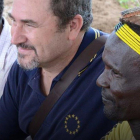Wag-Hemra Social Transformation Programme (Ethiopia). ACF/Save the Children/EU. 2016
Executive Summary
This report contains four sections. The first assesses the agricultural capacity of the Wag Hemra
Zone and the number of people who might be sustained from purely rural livelihoods. Currently
about 500,000 people live in the zone of whom at least 50% live on holdings that are too small
to provide a adequate livelihood, leading to seasonal urban migration as an increasingly
important means of survival. If land were to be redistributed so that each holding was adequate
to support an average household, HEA analysis suggests that no more than 370,000 people
could be supported from purely rural livelihoods, while 130,000 would be obliged to migrate to
towns.
As a consequence of that analysis, a Social Transformation Programme is described in the
second second section that would facilitate the transition to urban livelihoods. The programme
design is based upon interviews with stakeholders including migrant youth, urban employers,
brokers and relevant authorities. Logical Framework Analysis of their responses led to a three
pronged programme based upon the needs to:
a). enhance skills,
b). find employment,
c). change the mindset of both employers and employees from one focussing on a short term
relationship to one in which longer term employment can give rise to an increased return on
employer’s investment, improved productivity, higher remuneration and ultimately a sustainable
urban livelihood for each employee.
The activities proposed to achieve these ends are not described in detail. Instead, the
programme design focusses on the institutional arrangements under which the necessary
activities might be implemented. Three institutions are proposed:
1. YES hubs in rural areas.
2. Brokers’ Associations in urban areas
3. Social centres in urban areas for migrant youth, based on the principles of the Edir.
The programme design considers each institution in turn describing where necessary how each
might be set up and which activities might be conducted under the auspices of each one. A
summary highlights the advantages of the institutional approach in terms of sustainability and
discusses the critical assumptions upon which the programme is based, especially that of Zonal
and Regional authority support.
The third section considers an alternative approach to youth employment focussing upon
existing businesses set up within Wag Hemra Zone by groups of rural youths, that may have
potential but are undercapitalized. The proposed programme would broker investment into such
businesses. The brokerage function would require the identification of businesses with potential
together with willing investors. The two parties would then be introduced and the programme
would facilitate the negotiation of an appropriate business relationship allowing the investor to
take a substantial share in the business in return for financial investment and (as much as
possible) business experience and contacts). The programme would oversee the investment
and would monitor the business for a reasonable period to ensure the resulting arrangements
were equitable for all parties. It is envisaged that such a programme might attract matching
grant finance, in which case, the programme would also be required to manage the
disbursement of that finance to the business.
The fourth section considers two supplementary sources of income that might be developed in
Wag Hemra, based upon indigenous tree products. The first - frankincense - is limited in its
usefulness by the low density of Boswellia papyrifera that remain in the Zone. It is not expected
that the harvesting of resin would provide much increase in revenue under current conditions.
Nevertheless, a programme incorporating frankincense might be more appropriately developed
as a response to soil conservation and climate change rather than as an immediate source of
income. From that perspective, the development of new Boswellia stands that would generate
income in 15-20 years time might be worthwhile. If such a programme were to be financed using
the substantial funds available to address the issue of climate change, it might also make a
difference to current income levels for a limited number of households tasked with the planting
and care of young trees. Such activities might also be considered as alternatives to exiting
PSNP public works which appear to have done little to improve productivity within the area.
The second product - Baobab fruit powder - is derived from the fruit of trees that are common in
parts of the Zone and which are currently not utilized. The powder fetches substantial prices in
retail and wholesale markets and the number of baobabs in Wag Hemra is sufficient to support
a viable value chain. The technology of extracting the baobab fruit powder is simple and could
be undertaken at the village level. The process of collection can be readily organised. While
these factors suggest that the exploitation of baobab fruit powder might significantly enhance
incomes within the Zone, such benefits are very much dependent upon the development of the
market to absorb the product. The key challenges to improving livelihoods through baobab fruit
powder thus lie outside the Zone in the development of appropriate relationships in international
markets. If this can be achieved, the product will undoubtedly have the potential to impact rural
livelihoods in parts of Wag Hemra quite substantially.

Log in with your EU Login account to post or comment on the platform.